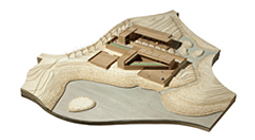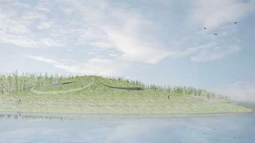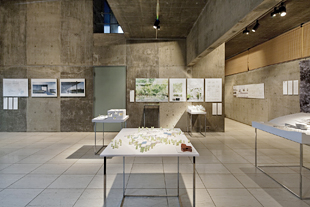 |
|
 |
The glass ceiling and grid-like patterning of glass walls in Sou Fujimoto's proposed entrance hall for Shanghai's De Museum Complex create an atmosphere that, in the architect's words, "is more like a forest than a forest."
© Sou Fujimoto Architects |
|
Tadao Ando's solution for Korea's Bonte Museum creates twin volumes with converse interiors -- one airy and open, housing contemporary works; the other contained and contemplative, for traditional crafts and arts.
© GA photographers |
There's less than a week to catch the nineteenth annual GA Japan 2010 -- Contemporary Japanese Architects exhibition at Tokyo's GA Gallery in Sendagaya through January 23. But if you miss it, a full catalogue of its nine featured projects by the country's foremost designers is published, in Japanese, in volume 107 of GA Japan.
In fact the "Global Architecture" enterprise's three magazines and quarterly exhibitions work in tandem throughout the year to summarize nascent trends in Japan and abroad, and the well-curated, if somewhat sparse, selections of conceptual drawings, models, and schematic plans at these exhibitions are familiar checkpoints for students and serious followers of the field. Held each November through January, the GA Japan show focuses solely on works by Japanese architects. While some visitors may find the displays quite specialist in orientation, the models and conceptual drawings are better appreciated in person than on the flat page, and a slideshow of several of the featured projects this year includes documentation used in actual client presentations, affording a different, boardroom view of those architects' signature styles. In all, GA Japan 2010 features nine projects -- by Tadao Ando, Sou Fujimoto, Arata Isozaki, Toyo Ito, Atsushi Kitagawara, Kengo Kuma, Ryue Nishizawa, Kazuyo Sejima + Ryue Nishizawa / SANAA, and Riken Yamamoto -- that are now on the drafting table, were submitted in competition, or are presently under construction in five countries in Asia and Europe, a compact roundup of the diverse design talents leading the field in Japan.
 |
|
 |
Kengo Kuma's design for Riverside Gallery in Korea conceals this museum for international works of miniature art within an existing hill, realizing the architect's vision of transparency as "the erasure of architecture."
© Kengo Kuma & Associates
|
|
Upon entering the gallery, one's line of sight is drawn immediately to these conceptual drawings by Atsushi Kitagawara for a new wellness center in Trentino, Italy.
© GA photographers
|
Two of the nine exhibits provide eye-candy for those less technically inclined. Kuma's six drawings for Riverside Gallery, a project now under design for a private art collector outside of Seoul, Korea, wield a soft palette of colors and a dreamy, painterly touch complete with tiny storybook-like figures that recall Mitsumasa Anno's wordless "Journey" series: a solitary cyclist pedals along the river's edge, her reflection caught on the water's surface; a man and woman gaze at one another from afar; waterfowl glide overhead. The effect is endearing -- poetic, even -- and piques curiosity about this subterranean museum where architecture and environment are dissolved into one.
Kitagawara's two conceptual drawings for a wellness center under development at the Terme di Comano spa resort in Trentino, Italy -- brushed in bold black and white on huge panels of washi-like paper and signed by himself and his team -- anchor the gallery's back wall like striking pieces of abstract art. In fact they reveal the architect's wish to express, through his unique scheme for the roof, the Japanese aesthetic of concealment and revelation as described in Jun'ichiro Tanizaki's In Praise of Shadows. "It's an aesthetic that, like a mist rolling in over hills, works to stimulate, rather than to guide or control, our imagination," Kitagawara explains. "When reclining spa-goers look up to the ceiling to find semi-hidden spaces in which their thoughts have free rein to roam, their relaxation will be enhanced." Early-stage presentations such as these, with their appeal to the senses rather than to structural or functional concerns, invite contemplation about the architect-client relationship. Indeed, the designer -- as artist, businessperson, and engineer -- must engage the heart and intellect of the client many times over throughout the long process of design development.
As Kitagawara explores the metaphor of mist to shape his invention, Fujimoto is revisiting one of his favorite analogies -- the forest -- to bring depth of field to his proposed spaces for the De Museum Complex in Shanghai, China. In his present scheme, a tree-filled, glass-enclosed interior segues with a courtyard, juxtapositioning multiple layers of glass and greenery to blur the boundaries between inside and out, the man-made and the natural environment.
Ando's and Ito's projects, also museums, are similarly concerned with integrating the way in which we experience architectural space and landscape. In his competition proposal for Museo de la Vega Baja in Toledo, Spain, Ito furthers his ongoing study of polyhedral forms with a primarily hexagonal grid that would adapt to the contours of the site by employing irregular angles; for the Bonte Museum on Korea's Jeju Island, Ando links two discrete L-shaped volumes on a terraced site via landscaped pools and indigenous wall design.
The remaining works on display -- a concert hall by Isozaki in Harbin, China; residential projects in Tokyo and Seoul by SANAA and Yamamoto; and Nishizawa's park-like traffic plaza, consolidating access to Kumamoto Station as the March 2011 completion of the Kyushu Shinkansen line nears -- offer still more views of what's on the desks and minds of Japan's top designers right now. The gallery's next exhibition, GA Houses Project 2011, is scheduled to run from March 19 to May 29 and will examine international trends in residential design through the works of 40 or 50 architects. Look for the full catalogue in volume 120 of GA Houses.
 |
|
 |
The clean geometry of the GA Gallery itself, and the exhibition's trim presentations, invite us to ponder the inherent complexity of the design process.
© GA photographers
|
|
GA Gallery's cozy but well-stocked bookshop, open daily even between exhibitions, is always pleasant to browse.
© Susan Rogers Chikuba
|
|